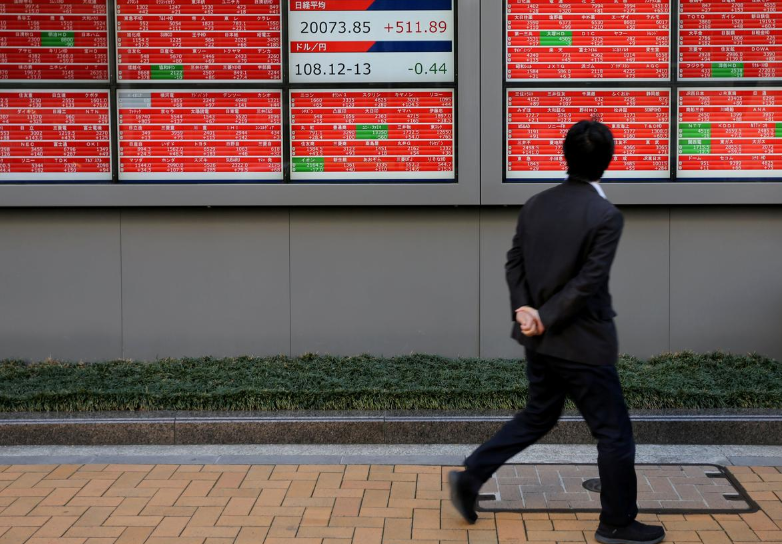
Asian shares steadied on Monday as investors caught their breath following another week of escalating U.S.-China trade tensions, with sentiment turning brighter after the United States said it would lift tariffs in North America.
MSCI’s broadest index of Asia-Pacific shares outside Japan added 0.6%, reflecting modest gains in markets across the region after the broad index finished at its lowest since Jan. 24 on Friday, down 3% for the week.
Australian shares underpinned the market’s firmer mood, jumping 1.7% after the center-right Liberal National Coalition pulled off a shock win in federal elections, beating the left-wing Labor Party.
Election results also look set to lift markets in India. India’s NSE Stock Futures listed in Singapore rose 2.4% and the rupee strengthened after exit polls showed Indian Prime Minister Narendra Modi is likely to return to power with an even bigger majority in parliament.
Shares in the trade-sensitive markets of South Korea and Taiwan also rose. The Taiwan SE Weighted Index added 0.3% and Seoul’s KOSPI rose 0.6%.
U.S. S&P 500 e-mini futures also turned higher, rising 0.3% following losses on Wall Street on Friday.
“We’ve had such a volatile few days in terms of pronouncements and interpretations of what’s going on with this potential trade war. And I think the news bites that we had over the weekend seem to indicate a softening of Trump’s approach toward tariffs internationally,” said Jim McCafferty, head of equity research, Asia ex-Japan at Nomura.
The U.S. announced on Friday that it would remove tariffs on Canadian steel and aluminum, prompting Canada’s foreign minister to vow the quick ratification of a new North American trade agreement.
“I think people might take the view that perhaps a similar strategy might be applied to Asia,” McCafferty said, referring to the lifting of tariffs.
The cautious optimism failed to lift Chinese blue chips, which fell 1%.
Japan’s Nikkei stock index added 0.3%, after data showed growth in the world’s third-biggest economy unexpectedly accelerated in the first quarter.
Modest gains on Monday came even as financial markets remained on edge over the intensifying Sino-U.S. trade war, with the Trump administration last week adding Huawei Technologies Co Ltd to a trade blacklist.
The repercussions of that move were evident as Alphabet Inc’s Google suspended business with Huawei that requires the transfer of hardware, software and technical services except those publicly available via open source licensing.
Google’s suspension of business with Huawei “signals that even though the trade talks are being characterized as being stalled, when we factor in China saying there is no point (in) U.S. negotiators coming to Beijing in current circumstances as they did Friday, then the chance of a G20 deal seem more remote,” Greg McKenna, strategist at McKenna Macro said in a note to clients.
Noting the festering trade war, continued uncertainty over Brexit and rising tensions between the United States and Iran, McKenna said investors are currently “headline trading.”
“(It’s) too soon to see the economic consequences of the battle escalating. And so belief can be suspended until that time,” he said.
OIL JUMPS
Rising tensions in the Middle East, which have supported oil prices, ratcheted up another notch on the weekend as U.S. President Donald Trump issued new threats, tweeting that a conflict with Iran would be the “official end” of that country.
But it was comments from Saudi Arabia’s energy minister that had the most immediate effect on crude prices on Monday.
Saudi Energy Minister Khalid al-Falih said that there was consensus among the members of the Organization of the Petroleum Exporting Countries to maintain production cuts to “gently” reduce inventories.
Both U.S. crude and Brent crude jumped more than 1.4% following the minister’s comments, with West Texas Intermediate fetching $63.66 a barrel and Brent crude at $73.27 per barrel.
In currency markets, China’s offshore yuan rebounded after touching its weakest against the dollar since November on Friday. It was last trading at 6.9351 per dollar.
In onshore trading on Friday, the yuan had weakened past the psychologically important 6.9 per dollar level to end at its softest in 19 weeks. However, sources told Reuters the country’s central bank is expected to use foreign exchange intervention and monetary policy tools to stop it weakening past the 7-per-dollar level in the near term.
The People’s Bank of China said on Sunday that it would maintain basic stability of the yuan exchange rate within a “reasonable and balanced range.”
The onshore yuan strengthened to 6.9081 per dollar on Monday.
The dollar added 0.12% against the yen to 110.20, while the euro was barely changed at $1.1155. The dollar index, which tracks the greenback against a basket of six major rivals, was up a hair’s breadth at 98.018.
The yield on benchmark 10-year Treasury notes rose to 2.4015% compared with a U.S. close of 2.393% on Friday, while the two-year yield touched 2.2146%, up from Friday’s U.S. close of 2.202%.
Gold trimmed earlier gains on the modest revival in risk appetite, easing to $1,276.91 per ounce.























